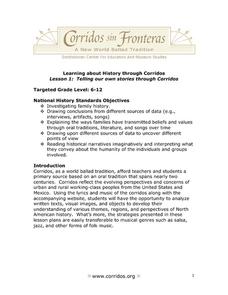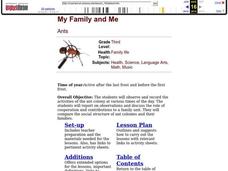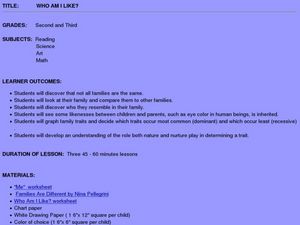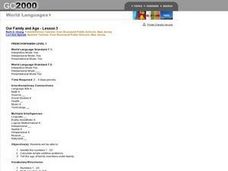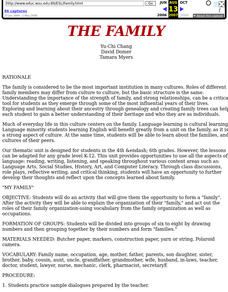Curated OER
Family Structures
Students organize information about their family into a family record. In this research lesson, students collect information about their families and organize it chronologically.
Curated OER
Family Life in the 1830s
Students compare and contrast family life today with family life in the 1830s. They conduct research on Old Sturbridge Village, read primary source documents, and develop a list of generalizations comparing/contrasting families of the...
Curated OER
Celebrate Family Story Month
Creative lesson and activity ideas that record family stories and memories.
Curated OER
A Heritage Study: Using Information Resources to Research Family History and Traditions
Students research their family history through ethnographical study. They locate information through a variety of sources, interview people, write a report and present an oral presentation to the class.
Curated OER
Passing Down Family History Through Oral Tradition: Corridos
Students create and perform Corridos which are oral tradition ballads. In this Passing Down Family History Through Oral Tradition instructional activity, students interview family members using a predetermined list of questions. In...
Curated OER
My Family and Me
Third graders observe and record the activities of the ant colony at various times of the day. They report on observations and discuss the role of cooperation and contributions to a family unit. They compare the social structure of ants.
Curated OER
Topic Sentences
Here is a classic worksheet that allows learners to practice identifying topic sentences. They read five different paragraphs about various topics, and underline the topic sentence in each paragraph with a green crayon.
Curated OER
Tutti Frutti
Get some competition going in your life science class. Give lab groups a variety of plant parts, all of them fruits, except one. Their mission is to make observations, compare and contrast, in order to be the first to identify the...
Curated OER
The Paths of Literature: The Family Today
Use the internet to research the differences between families in the past and today. In groups, they identify the reponsibilities and roles of each member of the family. As a class, they compare and contrast non-fiction and fiction and...
Curated OER
Who Am I Like?
Young scholars examine family structures. In this family structure activity, students discover things about their own families and those of their classmates. They make a chart as they discuss nature versus nurture, complete a worksheet...
Curated OER
Family Forms
Students discuss how the family structure has changed over time. In groups, they identify the strengths and weaknesses in each family form and functions. To end the lesson plan, they share their own family's structure and take a short...
Curated OER
All About Me, My Family and Friends
Students use general skills and strategies of the writing process to show their role in their family, school, friendships, the community and the world. They demonstrate their self-motivation and increasing responsibility for their own...
Nancy Fetzer's Literacy Connections
Expository Paragraph
Upper elementary and middle school writers learn how to craft an expository paragraph by following the six steps detailed in a 48-page instructional guide. Learners learn how to write six different types of informational paragraphs: to...
Curated OER
Print & Go ESL
Improve reading comprehension with a set of ESL worksheets. Kids read through various passages, note which facts are true or false, mark their opinion on two statements, and write a short reply based on a writing prompt.
Curated OER
What is a Family?
Students explore how Canadian families have evolved over time. In this census results lesson, students examine the factors that contribute to changing family and household structures. Students also create written and illustrated profiles...
Curated OER
Various 135: Fill In Sentences
In this sentence structure activity, 3rd graders choose the proper word to complete the ten given sentences. This is an interactive, multiple-choice activity.
AAAS
Identification and Classification of Grassland Plants
Take learning outside and start classifying grasslands. Young ecologists observe grassland plants in order to classify them into the appropriate species by family. They note their characteristics and where they grow. A true field...
Curated OER
Our Family and Age
Start by playing a song about numbers. "Sing, Dance, Laugh, and Eat Quiche" is suggested. Then, start counting things around the room. Introduce yourself, and have kids start to introduce themselves when they catch on to the vocabulary....
Curated OER
Revising Paragraphs With Excessive Coordination
For this grammar worksheet, students rewrite two paragraphs using various sentence structures to make each paragraph more coherent and interesting.
Virginia Department of Education
Owl Family Natural Selection
How do genetic mutations within a population lead to future variations? Provide your class with the resources to answer this question and more upon completing an activity on natural selection. The entire class participates in a fun role...
Curated OER
Lesson: David Goldblatt: Structures and Normativity, looking at Photography
Art can be a vehicle for social change and cultural expression. Upper graders examine the art of photographer David Goldblatt, as it pertains to apartheid, South Africa, and the AIDS epidemic. Discussion questions and image links are...
Curated OER
The Family
Young scholars investigate family organization and create a family unit. They decide the relationships, make ID's, and makes a family tree. They introduce their family units to the others in the class while the teacher takes family...
Curated OER
Family Stories and Personal Narratives
Fourth graders read various stories in their literature books about families. Individually, they make a timeline showing the most important events in their lives. They bring in one artifact from their lives and write a paper about it...
Curated OER
Friday and Friends: A Prospectus of the Mexican Family through Children's Literature
Students use literature to examine how the structure of families in Mexico has changed over time. In groups, they examine how their life now relates to their ancestors and the Spanish conquest of the area. As a class, they are read...






